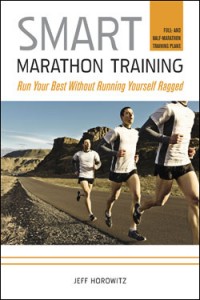By Jeffrey Horowitz
Jeffrey Horowitz is a certified running and triathlon coach and a personal trainer. Formerly an attorney, Horowitz quit law to pursue his passion for endurance sports. In this article, the expert shares tips from his second book ,“Smart Marathon Training,” on how to train better and run smarter.
I first started running as a way to relieve the stress of grad school. I ran my first marathon in D.C. back in 1987. It really helped me define myself and get focused. I just loved that. I’ve now run 171 marathons, at least one in every U.S. state and all around the world. I had so many really extraordinary moments that became the most important parts of my life, and I’m able to share with other people and help them realize their dreams.
SET A REALISTIC GOAL
The thing about the marathon is that it’s a great challenge, and I tell people to be realistic about their goals. There are some concrete rules of thumb about setting goals.
First of all, you should follow what we call “the rule of 10 percent,” which means from one week to the next, you should not increase your overall mileage by more than 10 percent. Give yourself enough time to build up slowly. That way, the chance that you’ll successfully run a marathon will be much greater and you’re less likely to get hurt. I recommend using shorter races to get an indication of where you are. You can occasionally do a couple of 5ks, 10ks, may be even a half-marathon as part of your buildup. If you run a half-marathon at an eight-minute pace, you can feel pretty confident that you can run a four-hour marathon. On the other hand, if you feel it is difficult to maintain a nine-minute pace, you may need to be realistic about your goal. So setting benchmarks throughout your training, where you can see where you are physically, is really a good idea.
GRADUALLY INCREASE DISTANCE TO AVOID INJURY
To gain endurance, you need to log miles in order to improve, however, as we run we also tend break down, so it’s prudent to work on strength exercises too. The research shows that the benefits of running top out around 35 miles per week, therefore, running daily may not work for some when it works just fine for others.
For those who run 50 miles per week, the chance that you’ll get an injury increases dramatically. So you need to preserve yourself and also do other things that complement your running to make you a healthy, injury-free athlete. That’s what “Smart Marathon Training” is about. You should have a goal in mind and be very targeted to reach that goal. That’s what I call purposeful training.
TRAIN SMART WITH ECONOMICAL APPROACHES
When you run, you’re on one foot and your body is twisting. It is a position that increases instability. If your body is not strong enough to hold your form, that could lead to injury. Find ways to build your body and make it strong enough to hold the form as you run. Research shows that cross training, like cycling in particular, works complementary to your muscle groups. The same holds true with strength training. So workouts that involve swinging or unstable position holding—things people who do pilates and yoga might be familiar with—can build your core strength and muscles.
FOLLOW A COUPLE Of ESSENTIAL WORKOUTS
There are three essential workouts you should be doing as you work toward your racing goal.
One is endurance-building workout—a longer, easier run. Another is speed workout or interval training—a shorter, more intense training. The third is what we call a tempo run—a long, sustained effort that’s more intense than the easy long run, but not as intense as the interval speed run. These are the three workouts you can do every week. They are targeted to different aspects of your running and will help you move toward your goal.
Once you’re done with these three workouts, if you want to run a fourth or fifth day, you could—but I don’t see exactly what purpose it serves in terms of moving toward your goal. Again, if you just love running, and if you’re healthy, that’s fine. But if you are trying to meet goals, then you have to seek other workouts like cross training or strength training. Say you cycle for two days to complement strength. Or, if you do very targeted strength trainings, then some days you don’t have to go to the gym at all; you can do it at your home, which may take only 20 minutes. In that way, you’ll find it might not take as much time preparing for marathon as you thought it would. If you do three targeted runs per week, a couple of cycling sessions, a couple of relatively short strength trainings, then you’re being very purposeful in your training, and the result will be more efficient; you won’t spend a lot of time doing workouts that are not really helping you move toward your goal. It’s quality training, and you’ll find you have more free time.
SHOE CHOICES VS FORM
One of the hot topics about running is whether you should use minimalist shoes. I love that people are paying more attention to how they’re running and what equipment they use. I think minimalist shoes are fine; however, research shows that if you run correctly, what you wear on your feet is less important than the form you’re using. The number one thing I tell people is try to run with as light footsteps as possible. Don’t slap the ground hard. If you can run quietly, the risk of getting hurt will be much lower.
ENJOY THE RACE
Every time you cross the finish line of a marathon, it should be a celebration. You should be really thrilled with yourself, regardless of whether you hit the goal you originally set. Enjoy the experience. A marathon should give you some insights into who you are, how tough you are, how capable you are, and how strong you are—emotionally and physically.
Jeff Horowitz will be publishing his third book, “Quick Strength for Runners”, this November, in which he shares an eight-week program you can do at home to become a stronger, more efficient, injury-free runner. For more training tips, visit Jeff Horowitz’s website: http://smartmarathontraining.com/











